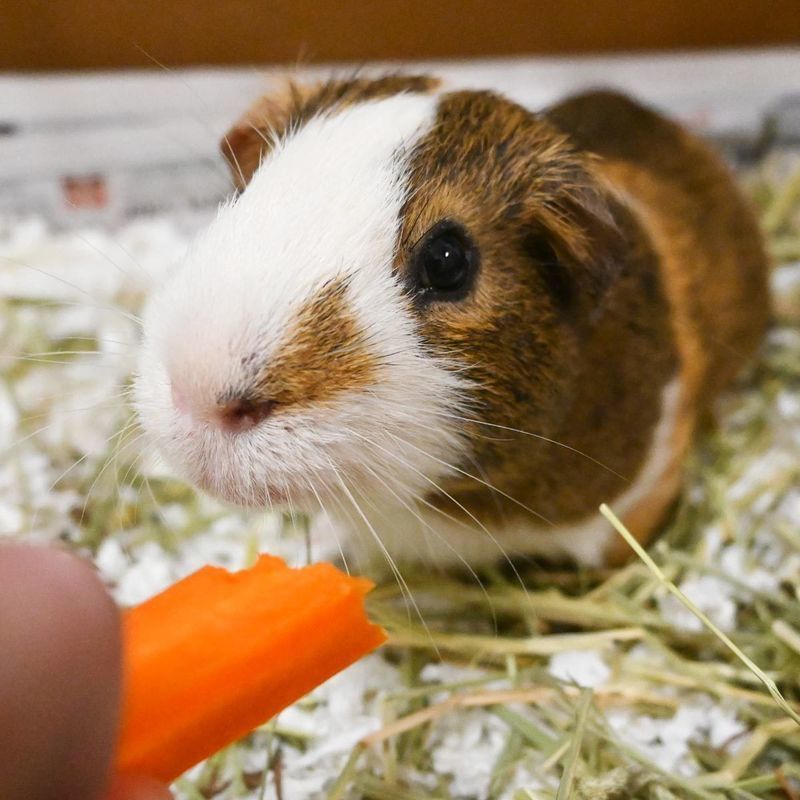Guinea pigs can be a great addition to any family! Being larger than other pocket pets, guinea pigs are usually a good match for small children. They are daytime critters and are slower moving than hamsters or gerbils, making them easier to handle. They also have a generally happy disposition and rarely bite. This, along with their amusing squeaks, grunts and adorable looks, makes guinea pigs an irresistible small pet.
Fun Facts and Information About Guinea Pigs
Guinea pigs are native to South America.
Another name for guinea pigs is "cavies."
Males are boars, females are sows and babies are pups.
Guinea pigs attain sexual maturity between four and seven weeks of age.
In both boars and sows, teeth chattering is the precursor to a fight, and nasty bites can follow if no one backs down.
Cavies often squeak and grunt as they move about, which is a sign of general contentment.
Guinea pig teeth and molars grow continuously.
Guinea pigs have 4 toes on the front feet and 3 toes on the back feet.
While grooming, guinea pigs may produce a white liquid in the eye. This is a normal reaction that washes away particles that lodge in their eyes.
Guinea pigs will make several short leaps in rapid succession called "popcorn jumping" or just "popcorning." This is a sign of a happy and healthy pig.
One Pig or Two?
Guinea pigs are social, so having a same-sex pair is often recommended. You do not need littermates, but getting two young pups works better than trying to match two adult sows (females) or boars (males). It is not a good idea to separate a bonded pair, as they can get very depressed and lonely.
A Castle to Call Home
Due to their larger size, a wire cage with a solid bottom (2'L x 2'W x 14"H) is necessary to keep one or two pigs comfortable. Guinea pigs have small feet with no bottom padding. Therefore, wire bottom cages are painful, and if their feet fall through they can break if they panic while trying to free themselves. Aquariums offer little to no airflow, causing smell and ammonia to build up that can lead to respiratory problems.
Bedding for Your Pig
Shredded paper or recycled paper bedding are the most appropriate and safest forms of bedding for guinea pigs. DO NOT USE CEDAR! Softwood shavings such as cedar and pine shavings have phenol oils that are toxic to guinea pigs. Pine shavings may be used if they are kiln dried (not air dried) to reduce the phenol oils in the wood. Aspen shavings are safe for guinea pigs, as they are from a hardwood that does not have the problems with phenols associated with the softwood beddings. (More information at www.guineapigcages.com/bedding.htm ).
Grooming Your Pig
Guinea pigs may be bathed on occasion, but only if really needed. Bathing removes natural oils in the skin and will dry out the coat. Nail clipping every two weeks is important to prevent their nails from growing too long and curling into the pads of their feet. Teeth may also need to be trimmed if they do not wear down on their own with chew blocks. With proper care, your pig friends can be a member of your family for 5-7 years or more.
What's For Dinner?
Guinea pigs should have an unlimited supply of timothy hay or other grass hays such as orchard hay, botanical hay, and oat hay. Alfalfa hay is very rich in protein and, although it is great for young, growing cavies, it should be avoided in adult cavies six months of age and older. Excessive protein can cause obesity and health problems in adult cavies.
Guinea pig pellets made from alfalfa or timothy hay are available. Alfalfa pellets are the most common, and are great for growing cavies under six months of age, but since they have more protein they should be given in limited quantities to adult cavies. Timothy pellets are preferable for cavies over six months of age. (See the Proper Guinea Pig Diet page for more information.)
It is important to stay away from "gourmet" pellets that include peanuts, seeds, colorful cereal and other additives. Cavies can choke on the seeds, and these added things can be comparable to "junk food" for people and are unnecessary.
Treat your cavy with fresh greens, veggies, and fruits! These should be given on a daily basis in limited quantities. It is also important to switch fruits and vegetables up regularly to offer a more diverse and interesting diet for your cavy. Stay away from commercial cavy treats, such as yogurt drops or honey seed treats. These have too much sugar and are not healthy for cavies. (For a list of good and bad greens, fruits, and veggies, see the Guinea Pigs: What to Feed tips.)
Vitamin C is extremely important for guinea pigs as they cannot manufacture their own vitamin C. They require 10-30 mg daily to prevent scurvy. Vitamin C should be given in tablet form, not added into the water as there is no way of knowing if they will receive the right daily amount when drops are added in the water. Fruits and vegetables containing vitamin C can be given as an alternative, but it is harder to measure out the correct dose of vitamin C needed.
Chew On This
Chewing is part of a guinea pig's natural behavior, and helps them keep their teeth worn down. To keep pigs active and amused, give them untreated wood blocks, cardboard, paper towel rolls and toilet paper rolls. Avoid plastic toys and objects with sharp edges, loose parts, or soft rubber that pigs could chew into pieces and swallow.









